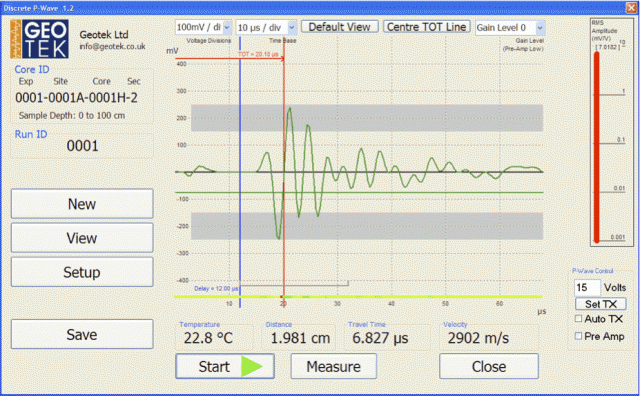 Discrete P-wave system
Discrete P-wave system
The MSCL-DPW Discrete P-Wave measurement system is a benchtop instrument designed to make precise measurements of P-wave velocity on rock or competent sediment samples. This single-task instrument can rapidly make velocity measurements on any rock sample irrespective of the sample shape. It is especially suited for making velocity anisotropy measurements on oriented cube samples.
Precise measurement
Velocity is calculated almost instantaneously from the sample thickness and the transit time of an ultrasonic pulse. A pulse transmission technique, combined with high-frequency digitization, provides highly repeatable and accurate travel times. The sample thickness is measured by an offset laser micrometer with a precision of better than 0.02 mm. When these measurements are combined for velocity, the precision is typically better than 5-10 meters per second depending on velocity and sample size.
Automatic voltage adjustment
Sediments and rocks can vary widely in how much they attenuate an ultrasonic signal. The MSCL-DPW’s automatic Tx function not only adjusts the signal level being applied by the transmitter but it also controls the gain (amplification) on the receiver side in a way that optimizes the signal quality and hence the data quality obtained. The user need only ensure that the received signal is inside the time gate, and the software will choose the optimal power and amplification for the signal. If the user wishes, these variables can also be controlled manually.

Clear signal display
The acoustic signal is clearly displayed in the software window, allowing the user to confirm the arrival pick. Delay time (“delay”) and threshold voltage are visible as lines on the virtual oscilloscope, which the user can drag using the mouse. Signal strength is displayed on the right, and calculated velocities are shown at the bottom of the display in real time.
 Ease of use
Ease of use
The upper P-wave transducer and laser distance sensor is connected to a sliding upper frame via a precision ball screw (15 mm pitch) and rotating handle on the top of the instrument. To make a measurement on a sample, the upper transducer is first raised by turning the handle anti clockwise; the sample is placed on the lower transducer and then it is lowered turn the handle clockwise) until it contacts the sample. The signal appears in the software window and a velocity is automatically calculated.
Repeatable pressure
For measurements on hard rock samples, it is important to apply a small but constant pressure on the sample during the measurement. This can be difficult to achieve manually, but is automatically accomplished with the MSCL-DPW. When the correct set pressure is reached on a rock sample the handle disengages from the ball screw preventing further pressure being applied. This enables the user to easily apply the same pressure on every sample for repeatable and consistent measurements.